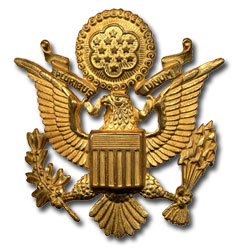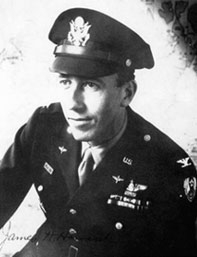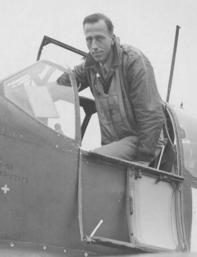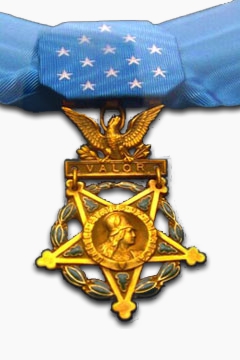Maj. James H. Howard, fighter pilot of the 9th Air Force. The Oeschersleben mission on 11 January, 1944
Back up, now, with the bombers, I saw a Messerschmitt 110. I shot at him and got strikes all over him. He flicked over on his back and I could see gas and smoke coming out white and black smoke. (Major Howard did not claim this ship as a "kill.") Bomber crews say they are sure this ship crashed but it could be that the fellow had some sort of smoke equipment to make it appear that he was damaged more than he was.
He says you could fly the Mustang in ordinary street clothes because it has a heater, but you go very high and you'd probably get a bit chilly.
I climbed back up again with the box of bombers which seemed to need me most. And right away I saw another Messerschmitt tooling up for an attack on the Forts. They often slip in sideways, the way this one was doing. We were both pretty close to the bombers and I was close to him. I gave him a squirt and he headed straight down with black smoke pouring out
Now I could see that each box of bombers was being harassed by attackers but the majority of them were out of range for me. I had to choose the most opportune target and dive on him before he was able to get within range of the bombers.
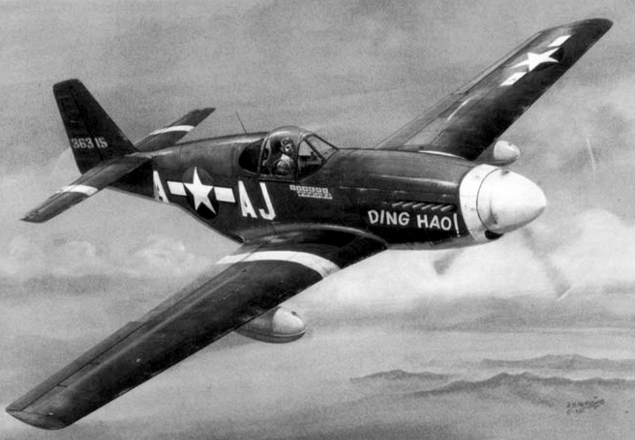
A painting of Maj. Howard's P-51B Mustang "Ding Hao!", by D.H. Herring.
Each time I would climb back up to bomber level only to find another enemy aircraft lining up for an attack. I was quite busy in a constant merry-go-round of climbing and diving on attackers, sometimes not firing, my guns but presenting a good enough bluff for them to break off and dive away.
On the first encounters and combat all four guns fired. On the third I had two guns and on the fourth and fifth encounter only one gun. When I got down to one gun I was still engaged in this dive, attack and climb game for another two or three attacks. The enemy aircraft and I would estimate that there were about 100 plus attacking aircraft throughout all the boxes during this period-seemed reluctant to stay and fight and would dive out. The reason for no other friendly aircraft being in the vicinity or with me was that other squadrons had been sent off to deal with attackers, and as I say, it's hard to estimate the number of enemy aircraft present during the major portion of this running fight, but all boxes I could see had some activity around them.
We were supposed on this trip to be with the bombers for about an hour. We had already gone over that time. But I had been using my ammunition sparingly and with one gun working I climbed once more to the port side of the bomber formation. I saw an ME over on the starboard side getting into position for his dirty work and I just dived on him from where I was. I got strikes all over him with my one gun. He turned over on his back and skidded out. He thought he had lost me with the skid and he pulled out into a forty-five degree dive, I followed him down and kept on shooting.
On the next trip up I saw a Dornier 217, I think it was coming alongside the big Friends, probably to throw rockets. I had to work fast but when I dived on him he just left and I never did fire a shot at him. I had to leave shortly thereafter, also. When I got home there wasn't anything more serious than a hole in my left wing. I don't know where I got it, or when.
If we had dispatched more fighters we could have bagged many more. There just weren't enough protection fighters to go around. But, using what we had on hand to good advantage, I believe we came out on top with an impressive score.
The Germans are good fighters. You really have to riddle them to bring 'em down, whereas a few hits on a Jap plane will finish it. The Japs aren't very good shots either, but they are more alert than the German pilots. The Japs flew different planes and the formations were different, so it is hard to compare the fight here with the fighting in the air out in the Pacific. This is the biggest air offensive center in the world here and it was on a small scale, remember, when we were fighting there with Chennault.
But you can be sure I never stopped what I was doing to count them. In slang words, I just seen my duty and done it.
I'll tell you one thing, though. You have a better feeling flying over France and Germany in a single-engine plane than you have flying in Burma. You have the feeling you'll get better treatment here if you go down. Over there once you are shot down you are either lost or you fall into the hands of the Japanese. I have a personal hatred for every Jap that I don't feel for the Germans.
Now since Major Howard had only reported two planes shot down, and since on that date three other pilots had also shot down two each out of the total bag of fifteen Germans, there was quite a mystery as to the identity of the lone eagle. Intelligence officers were happy to inform the inquiring bomber crew men that up to date Mustang fliers in a typical, all-American group, had shot down forty-eight, riddled scores of "probables" and damaged many, many others, all with a loss of only six planes, only two of which were shot down. And, they added within this typical group there was one squadron, that one led by Maj. James Howard, which had shot down twenty-two, got seven "probables" and damaged ten more, without loss to themselves. "Just count up those percentages," they suggested.
For another week the bomber crews and officers kept talking and wondering and then finally the films were studied and the encounter reports were written and all of them read carefully and there could be no doubt about it. This seemed certain to be one of those rare instances when a flier's claims would be doubled or even tripled by the confirmation board. If, as seems likely, six victories will be officially recorded, it definitely will constitute a one-day phenomena for combat.
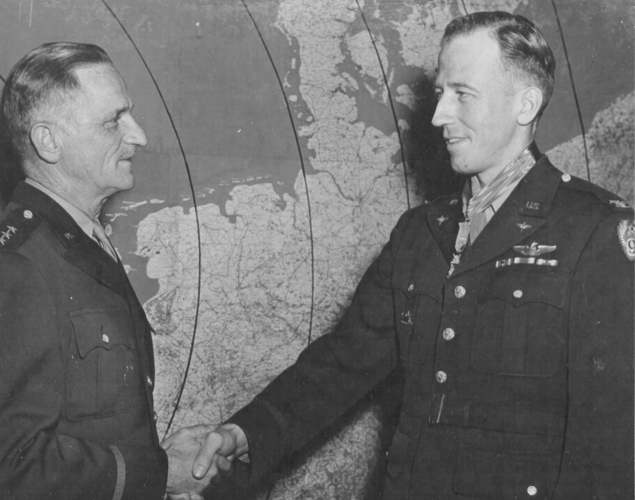
Colonel James H. Howard, right, former leader of the 9th Air Force Pioneer Mustang Group, receives the Congressional Medal of Honor from Lt. General Carl A. Spaatz, Commanding General of the U. S. Strategic Air Force in Europe, for his single-handedly defended a box of heavy bombers against 30 threatening German fighters on 11 January 1944, on the way to bomb targets in Oscherleben, Germany.
The men who fly with Major Howard know he has a special knack for the dogfight but despite all they know about his individual performances they tell you he is even more outstanding as an air commander. When the enemy is sighted he takes easy command of the situation and has a special genius for disposing his fighters to the best advantage, his deep, even tones coming over the radio in such a fashion as to instill the greatest confidence.
Therefore it seemed entirely logical when, one day over Germany, he saw ten Jerries approaching and told off a doughty fighter, "Take your wing man and go get 'em!" Odds of five to one! But without giving the matter much thought the fighters told off realized the major was saving his strength for the fierce battle he expected over the target. That was strategy. You must never let the enemy intercept and engage too much of your strength before you are near the target area.
"When he flies into enemy territory and the Huns come up," said Lieut. Mike Rogers, of Newton, Mass., "he, always saves the biggest group of enemy fighters for his own fight." He is direct in the air. In his dealings with his men on the ground they find him sincere, quietly sympathetic, not very communicative. He gets things done much of the time by indirection. The boys say they feel that may have come about because of his many years in the Orient. When he puts on wings he takes off his cloak of restraint.
So do the pilots who fly with him. They have developed into scientific daredevils. They fly closer to the enemy and do more of the supposedly unorthodox than any other bunch, and the others freely admit it. This spirit has swept the entire group, which is headed by a full colonel, only 27 years old, Kenneth R. Martin, also a Missourian who has to be shown. He's from Kansas City.
When I tried to congratulate Howard's fellow officers they showed me a batch of letters the major had received from Fortress bomber crews he'd protected that memorable day.
Col. Howard W. Bowman, commandant of a bomber station, wrote:
"In the full knowledge that words cannot be found which will adequately express our feelings, I wish to convey on behalf of our group the heartfelt appreciation which we feel as a result of the unbelievable courage and heroism you displayed on the recent Oeschersleben mission.
"Your unprecedented action in flying your P-51B alone and unaided into a swarm of German fighter planes estimated at between thirty and forty in an effort, to protect our Fortresses in the target area is a feat deserving of the highest commendation and praise. The fact that the odds were overwhelmingly against you and that you had no hope of receiving assistance in your unequal struggle did not deter you in your determination to engage the enemy.
"As one officer put it, "It was a case of one lone American taking on the entire Luftwaffe." Members of our group were lavish in their descriptions of the way you shot down enemy planes and, in particular, spoke in glowing terms of the attempts made to protect the combat wing against enemy attacks. I personally feel that your exploits that day evidenced the spirit of team work which is the sina qua non of successful military operations. Let me assure you that should you ever have occasion to visit this station your welcome will be a warm one. There is not a man in our group who hasn't sung your praises."
That letter was forwarded to Major Howard at the same time Major General Jimmy Doolittle ordered that a recommendation for "a suitable award" be drawn up. The award was the Distinguished Flying Cross. The citation which accompanied it spoke of Major Howard's "aggressiveness in combat and outstanding leadership as an aerial leader," a flier who inspired his men by personal example and indoctrinated them in a most successful combat technique.
There were other letters, dozens of them, where the officers who had been protected offered the keys to "the works" - planes, hangars and commissary. And to watch the major get set for his eighteenth mission, you'd believe he expected every day of combat to be a "champagne day." He smiled quietly through the briefing. Came the take-off and soon we could hear the radio busy giving directions to some of, the heavy armada who would have to come back because of trouble of some sort or another. We could hear the motors of the heavies which had made an abortive start. One landed at our base briefly and then went on home. It didn't seem long before we heard the electrifying words that meant all were over the target - which was Frankfurt, Germany-and that "Big Friends are being attacked."
And yet in the space of two hours all the Mustang pilots had come trooping into the interrogation room and were making calm, concise reports. The flak had been accurate at certain points, the weather had been "ten-ten," which means they hadn't been able to see the ground except on take-off and landing.
But they had done their jobs and so had the bombers. Germany had taken another shellacking and was down hill just that much more on the inevitable path to defeat.

